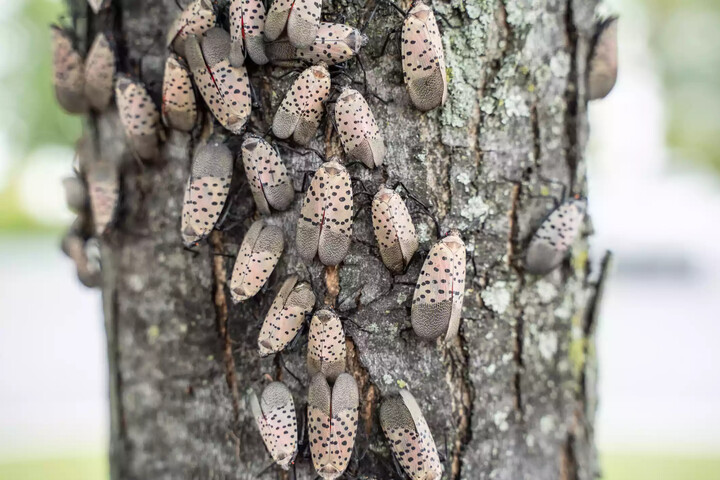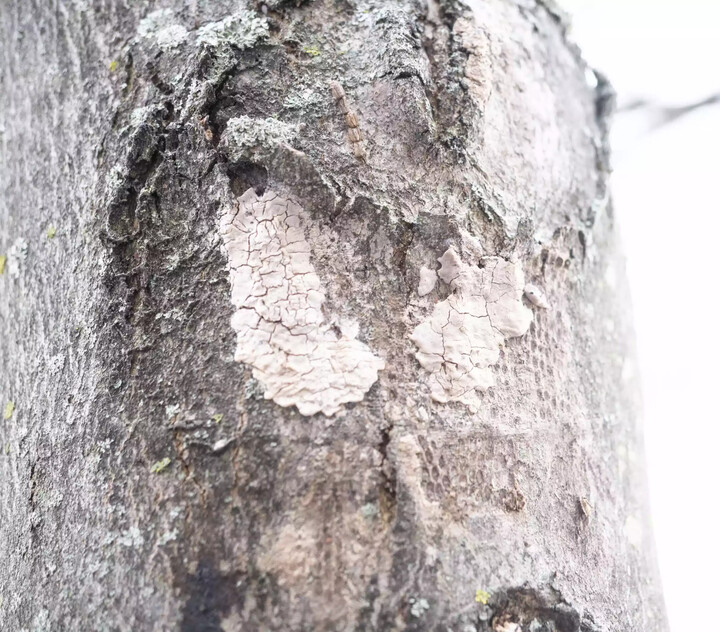The name spotted lanternfly (Lycorma delicatula), also referred to as SLF, is misleading because this invasive insect is a planthopper, not a fly. It is native to China, India, and Vietnam and first appeared in Pennsylvania in September 2014, from where it spread to currently half a dozen other states. Because the spotted lanternfly can only fly short distances and mainly jumps or walks, human activities are primarily responsible for transporting it across large areas.
The spotted laternfly in all its stages, from egg masses to nymphs to adults, can be hitchhiking on trees, plants, bricks, stones, firewood, building materials, patio furniture, vehicles, kiddie pools, and equipment such as lawnmowers—virtually anything outdoors that has a hard, solid surface.
With its piercing-sucking mouthparts, the spotted lanternfly drills into the phloem of a plant to feed on the sugary sap. It attacks a wide range of trees, fruits, especially grapes, and ornamentals, severely damaging the plants if not killing them. Its preferred hosts is the invasive tree of heaven.

Spotted Lanternfly Stages and and Identification
To effectively combat spotted lanternfly, it’s crucial to know its life cycle. It consists of four nymphal stages, the adult stage, and the overwintering egg masses. There is one generation per year.
Between September and November, the adult females lay their eggs on a wide range of hard surfaces such as trees trunks, decks, siding of houses, outdoor furniture, or rocks. The egg mass, which each contains 30 to 50 eggs, is protected with a waxy cover that is initially light gray in color but looks like dried mud as times goes on.

The egg masses remain until May or June of the next year when the nymphs start to hatch, a process that can extend over a period of two months. After about one month, these first instar nymphs, about one-quarter of an inch long, molt into the second instar, and after another month, into the third instar. All first three instars of the nymphs are black with white spots.
In the fourth and last instar, between July and September, the nymphs, about three quarters of an inch long, have red color in addition to the white spots.

Is Spotted Lanternfly in My State?
Spotted lanternfly is currently present in six states, where it is under quarantine: Delaware, Maryland, New Jersey, New York, Pennsylvania, and Virginia. Quarantine means that the movement of any materials or objects that could harbor the insect in any stages of its life cycle (egg masses, nymphs, or adults) is prohibited or requires a permit. If you are located in one of the six affected states, click on the links above for the latest information from the state’s department of agriculture.
Symptoms of SLF Infestation
The feeding of spotted lanternfly stresses a plant which, in combination with collateral damage from the feeding, can significantly damage a plant or kill it.
The nymphs and the adults suck large amounts of sugary sap directly from the phloem of leaves, stems, branches, and trunks. The nymphs of the first through the third instar also feed on tender young shoots of plants whereas the fourth instar nymphs and adults have mouth pieces strong enough to also attack older plant tissue.
After it feeds on the sap, the spotted lanternfly excretes the excess sugar in the form of honeydew onto anything underneath it—other vegetation, vehicles, decks, garden furniture, and even pets and clothing. The sticky surface is soon covered by sooty mold, a black fungus. Spotted lanternfly does not feed on fruit, but sooty mold makes the fruit unfit for consumption.
Affected plants may show oozing, wilting, defoliation, and dieback to the point of plant death. A plant weakened by a spotted lanternfly infestation is also more susceptible to other pests and diseases.

How to Prevent and Eliminate Spotted Lanternfly
The first measure is to make sure you don’t introduce spotted lanternfly to your yard. Carefully inspect anything coming from places within a SLF quarantine zone for the insect in any of its nymph or adult stages or the egg masses.
Scrape off any egg masses whenever you find them, even in the deepest winter. Any rigid scraper or putty knife works well. Scrape in a downward direction and hold a container underneath to catch the egg masses. To kill the egg masses before safely discarding them in the garbage, pour some rubbing alcohol or hand sanitizer over them.
Promptly get rid of any tree of heaven (Ailanthus altissima) because it is the preferred host of the spotted lanternfly.
Tree banding is an option to restrict the movement of the nymphs while they climb up and down tree trunks to feed. Special adhesive traps are available from gardening supply companies. Place them at chest level with their sticky sides to the outside and replace them every two weeks until the end of July.
Insecticides are not recommended for spotted laternfly control, as they indiscriminately kill beneficial insects. This also applies to systemic insecticides, which are sometimes used with tree of heaven as trap trees. Systemic insecticides are moved around in the plant tissue and kill the insects when they are feeding on the plant.